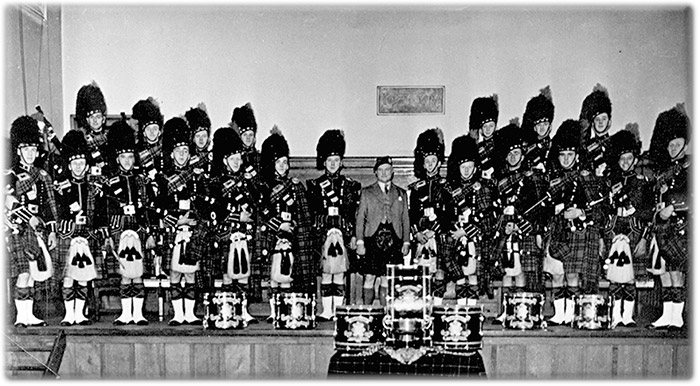
This history of the band is based on a combination of historical documents, interviews, and tales told by band members and others. I make no claim for detailed accuracy; and I would welcome corrections and/or additional material.
Often referred to as ‘the best band never to have won the Worlds’ the Red Hackle Pipes and Drums was in existence for around 35 years, always as a Grade 1 band. The band is pictured above in 1948.
By John Barbour
Perhaps its major claim to fame was the innovation it brought to the relatively staid pipe band scene in the 1960s and 70s under the leadership of P/M John Weatherston. These included introducing other instruments into band performances and recordings; and in the construction and playing of the medley selections which became part of the competition repertoire from 1970 onwards.
The Drum Corps played its part in helping to redefine the role of the percussion section in pipe bands. Up until the 1970s the drum corps was largely subservient to the pipe corps. It was supposed to fit in unobtrusively below the pipe tune and to try not to make technical errors. The bass and tenors were little more than time-keepers.
The key drivers of change included Alex Duthart at Shotts; Joe Noble at Renfrew; and the Red Hackle Drum Corps under Wilson Young, Norrie Thomson and Evan Jones. They were all striving to give the percussion unit a distinctive voice in the band; one which made its own particular contribution to the overall musical effect.
The Red Hackle Drum Corps had a strong sense that their role was to drive the band and not just to take a safe back seat. They were one of the first to play with nine side drummers and two bass drummers – when most Grade 1 bands struggled to come up with six sides.
And they were early users of drum salute techniques such as back-sticking and stick juggling, both of which are now commonplace. They had perhaps the finest bass drummer of his era in Willie MacIntosh, later to play with Shotts.
The band won every Major Championship except the Worlds, and they would finish second at the World Championships a total of three times.
The Red Hackle was formed in October 1947 by a group of WW2 Black Watch veterans taking their name from the the famous red hackle as worn by the regiment. Whisky magnate Charles Hepburn was the Founding Chairman and the main sponsor.
Charles Hepburn was a WW1 veteran who, after making his fortune from the national drink, determined to put something back into the country’s other great tradition: piping. He was an early sponsor of the World Championships and the nascent Scottish Pipe Band Association, and after WW2 he also more or less gifted a company warehouse in Otago Street, Glasgow, to the College of Piping, premises which remained its HQ until 2003.
Back to the band. Its name for a short time was the ‘The Govan and District Red Hackle Pipe Band’ and there were 18 pipers and four drummers. There is a sense of Army discipline at work in their early rules which state:
- missing three consecutive practices meant expulsion;
- there were twice yearly test pieces to be performed in order to retain membership, and
- you had to sign on for five years…but that only lasted until 1948
The early years were typified by acrimony rather than competitive success in Grade 1. Office bearers came and went and band members were frequently dismissed. For example, in March 1949 Drum Major F. Douglas was expelled apparently for ‘inattendance, lack of interest, and lack of practice’. Pipe Major Downie resigned at around the same time.
Things settled down somewhat under Pipe Major Angus MacLeod. He became the Pipe Major in 1949 and continued in post until 1963, despite labouring under ill health from 1951 onwards.
- To be continued. About the author; he writes: ‘My early teachers were Willie Barrie (pipes) and Alex Connell (drums). I was the Drum Sergeant in the Kilbarchan Pipe Band when they were in Grade 2; then I joined the Red Hackle when Norrie Thomson and Evan Jones were the leading drummers. I played in the Clan Campbell band briefly until pressure of work meant that the time needed to stay at the right standard was not available. I am a Management Consultant; and a long-serving Visiting Professor at the University of Strathclyde. My real claim to fame is that I am the only person – as far as I know – who has further learned to the play the pipes on a railway train. Every day on the 07:24 from Henley-on-Thames to London Paddington – a Technopipes chanter and the Scots Guards Vol.1. Not a good idea…’